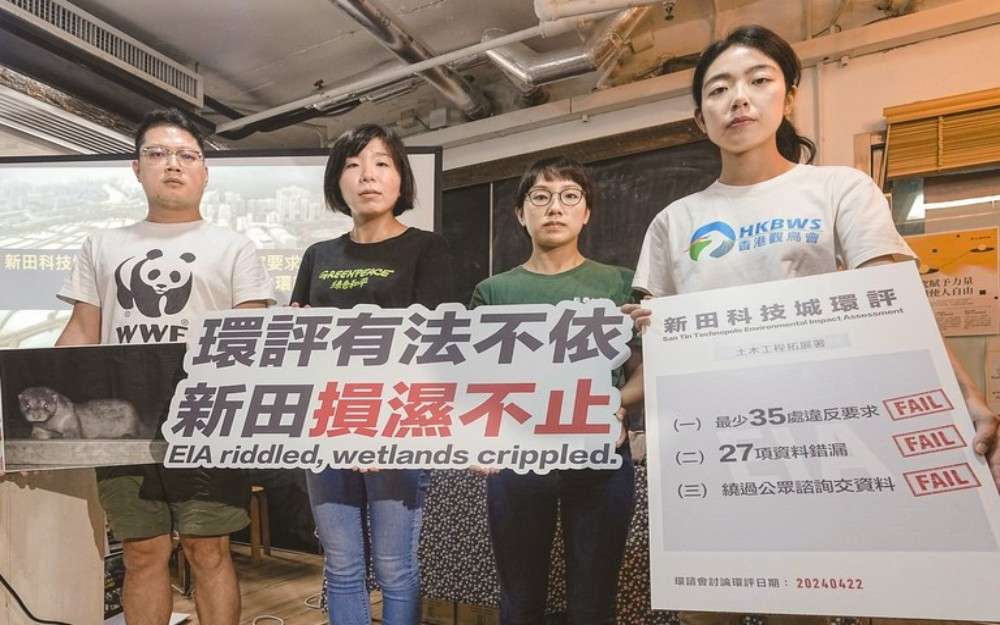The project doesn’t even align with government environmental plans from mainland China, birdwatchers say.
By Matthew Leung for RFA Cantonese

Environmental groups have slammed a Hong Kong government plan for a high-tech urban development despite warnings it will destroy a crucial wetland habitat for migratory birds, including the endangered black-faced spoonbill.
The city’s Advisory Council on the Environment approved a controversial environmental impact assessment for a high-tech development known as the San Tin Technopole on Monday, despite warnings from 10 environmental groups that it would cause the worst damage to the city’s coastal wetland and fishpond habitat in 30 years.
“San Tin Technopole … will cause the most extensive damage to wetlands in 30 years, and affect nearly 247 hectares of wetland conservation area and buffer zone land,” the groups said in a joint statement on April 17.
It hit out at the government for massively extending the planned area covered by the project at the last minute, but not including the extended plans in the existing assessment.
“The authorities refused to comply with the legal requirements of the environmental impact assessment, which may seriously underestimate the damage caused by this development to the wetland and fishpond ecosystem,” the statement said.
Officials had “omitted species and habitats” from their survey and made dozens of “serious technical assessment and data errors,” it said.
Flyway for millions of birds
Hong Kong’s coastal wetland forms part of the East-Asian Australasian Flyway, a route taken by tens of millions of migratory waterbirds including a large number of threatened and endangered species, according to the Worldwide Fund for Nature.
The birds rely on these habitats as a stopping off point to rest, feed and replenish their energy reserves while undertaking an arduous journey of more than 13,000 kilometers (8,000 miles) from breeding grounds as far north as the Arctic Circle to overwintering grounds as far south as Australia, according to the group’s website.

Environmental groups say the development will also affect local populations of wading birds, including the Chinese pond heron and the little egret.
“The pond reclamation project at San Tin Technopole will cause irreversible damage to fish ponds and wetlands,” the 10 environmental groups, which including Greenpeace, the Hong Kong Birdwatching Society and the Worldwide Fund for Nature, said, calling for a full public debate and review of the assessment, taking into account errors and omissions.
Meanwhile, the Liber Research campaign group said via its Facebook page on April 22 that the development was a “bulldozer-style development that has been questioned by environmental experts, who called it the biggest threat to coastal wetlands.”
It said the ecological value of the existing agricultural lands, which include dozens of fishponds, had been ignored.
‘Invaluable assets’
The Hong Kong Birdwatching Society said in a statement on its website that the project wasn’t even in line with mainland China’s environmental policy.
“The … wetland is a precious and unique coastal wetland resource in the Greater Bay Area, which should be protected to align with national policies,” the group said, citing the Chinese government’s 14th Five-Year Plan, which describes “clear waters and lush mountains” as “invaluable assets” to be preserved alongside human development.

It said authorities in the neighboring province of Guangdong had recognized the importance of ecological corridors for migratory waterbirds in its territorial and spatial plan for 2020-2035, while the Outline Development Plan for the Guangdong-Hong Kong-Macau Greater Bay Area pledged to “comprehensively protect key wetlands of international and national importance in the region and join hands to introduce measures to protect cross-boundary coastal wetlands.”
“The current development proposal of San Tin Technopole underplays the uniqueness of the [San Tin] wetlands in the Greater Bay Area and its importance in the International Flyway,” the group said. “It does not align with [China’s] national policy of Ecological Civilization.”
Conflict of interest?
The Liber Research Group meanwhile noted that the current chairman of the Advisory Council on the Environment, John Chai, is also involved in the developing the Shenzhen-Hong Kong Innovation Park, of which the San Tin Metropole will form part. Chai is listed on the Park’s official website as Alternate Chairperson.
Current affairs commentator Chung Kim-wah said the conflict of interest around John Chai alone would have raised tough questions in Hong Kong’s Legislative Council, back in the day when opposition candidates were still allowed to stand in elections, before Beijing tightened its political grip.
Public scrutiny of such projects would have been far more detailed and taken much longer, and once had the power to force the government to take public opinion into account, Chung told RFA Cantonese.
“However, the current government allows members with obvious conflicts of interest to chair Advisory Council on the Environment meetings, so this final decision isn’t surprising,” Chung said.
“It seems the international convention on wetland conservation is no longer taken into consideration by the government,” he said.

A neighboring area of wetland at Mai Po Marshes and Inner Deep Bay was designated a protected site under the Ramsar Convention in 1995.
The Ramsar website describes the area, which lies around 4 kilometers (2.5 miles) to the west of the proposed San Tin Technopole, as an area of tidal mudflats and tidal shrimp ponds that is home to 13 globally threatened species of birds and 17 species of invertebrates new to science.
The site regularly held over 20% of the global population of Black-faced Spoonbill between 2007-2012, while 26 other species of waterbirds are found in numbers amounting to more than 1% of their regional population at Mai Po, it said.
A spokesman for Hong Kong’s Environmental Protection Department said on April 22 that the environmental impact assessment process in Hong Kong was carried out according to “objective and clear principles, procedures, guidelines, requirements and criteria.”
The department will now “review in detail” the assessment and comments “raised by the public,” before making a final decision, he said.
However, Hong Kong Chief Executive John Lee appeared pretty confident that the San Tin project is going ahead.
“In Hong Kong, the [Shenzhen-Hong Kong] Park is within the San Tin Technopole area, which will emerge as our city’s largest I&T center by far – with some 300 hectares supporting Hong Kong’s rise as an international I&T hub,” Lee told the Park’s launch ceremony in Shenzhen on April 18.
“After years of planning and the hard, smart work of many parties, the Park is fast approaching the operational phase,” Lee said, adding: “More will follow.”
Translated by Luisetta Mudie. Edited by Malcolm Foster.
“Copyright © 1998-2023, RFA.
Used with the permission of Radio Free Asia,
2025 M St. NW, Suite 300, Washington, D.C. 20036.
https://www.rfa.org.”













